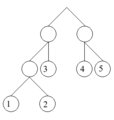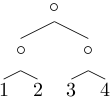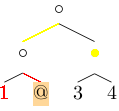Search results
Jump to navigation
Jump to search
Page title matches

File:Tree.png (269 × 282 (4 KB)) - 16:10, 17 April 2006
File:Tree-12-34.png Image for the ((1 2) (3 4)) tree(111 × 104 (2 KB)) - 11:28, 11 July 2007
File:Tree-like folding.gif Tree-like folding in composites production.(733 × 433 (5 KB)) - 14:00, 14 February 2013- [http://en.wikipedia.org/wiki/Abstract_syntax_tree Abstract syntax tree] at wikipedia.107 bytes (15 words) - 15:17, 6 February 2021
- ...st row are as far to the left as possible. Additionally, every node in the tree will either have 0 or 2 children. ...be given as input so that the value of all nodes can be calculated up the tree.5 KB (837 words) - 12:13, 4 August 2008
Page text matches
- (*) Construct the bottom-up order sequence of the tree nodes. ...which constructs the bottom-up sequence of the nodes of the multiway tree Tree.570 bytes (97 words) - 03:52, 10 January 2017
- (*) Check whether a given term represents a binary tree data Tree a = Empty | Branch a (Tree a) (Tree a)1 KB (156 words) - 13:35, 25 December 2016
- (*) Determine the internal path length of a tree. ...ree as the total sum of the path lengths from the root to all nodes of the tree. By this definition, <tt>tree5</tt> has an internal path length of 9.410 bytes (71 words) - 03:52, 10 January 2017
- data Tree t = Leaf t | Branch (Tree t) (Tree t) get_node :: Bits -> Tree t -> Tree t1 KB (178 words) - 15:53, 7 March 2007
- data Tree a = Leaf a | Branch (Tree a) (Tree a) deriving (Show, Eq) | L (Cxt a) (Tree a)6 KB (912 words) - 03:52, 8 October 2006
- (*) Count the nodes of a multiway tree. nnodes :: Tree a -> Int174 bytes (25 words) - 03:53, 10 January 2017
- ...n the Portage Tree,one of this in Stable tree and the second in the Tesing tree, that will generally be the latest ebuild launched, having the latest stabi Actually the latest Himerge version in Portage is 0.17 in ~arch tree.2 KB (375 words) - 04:11, 24 February 2008
- -- Generic zipper implementation for Data.Tree module Data.Tree.Zipper9 KB (1,028 words) - 06:36, 24 May 2008
- data Tree a = Node a (Tree a) (Tree a) | Leaf a instance Eq a => Eq (Tree a) where3 KB (399 words) - 21:04, 7 November 2011
- ...st row are as far to the left as possible. Additionally, every node in the tree will either have 0 or 2 children. ...be given as input so that the value of all nodes can be calculated up the tree.5 KB (837 words) - 12:13, 4 August 2008
- ..."parse tree for Haskell" is likely to be a concrete data type, whereas a "tree" data type is a corresponding [[Abstract data type]]. ...nteger</hask>, <hask>Bool</hask>, <hask>[(String,String)]</hask> and <hask>Tree String</hask> are concrete data types.864 bytes (135 words) - 22:06, 20 December 2006
- ...e difficult than insertion. His solution is to use a concrete view of the tree which simplifies the operation, and as a result, comes up with a new repres Here is a simple binary search tree type:5 KB (845 words) - 02:22, 4 January 2008
- ...order/2 that construct the preorder and inorder sequence of a given binary tree, respectively. The results should be atoms, e.g. 'abdecfg' for the preorder ...verse direction; i.e. given a preorder sequence, construct a corresponding tree? If not, make the necessary arrangements.2 KB (280 words) - 03:43, 10 January 2017
- ...ing some kind of binary tree, typically a size balanced tree or a Patricia tree. While binary trees provide good asymptotic performance, their real world p876 bytes (134 words) - 13:45, 17 December 2012
- import Tree (Tree (Leaf, Branch)) type CL = Tree BaseSymbol689 bytes (98 words) - 14:34, 4 August 2006
- (**) Lisp-like tree representation. The following pictures show how multiway tree structures are represented in Lisp.2 KB (276 words) - 03:52, 10 January 2017
- data Tree = Nil | Node !Int Tree Tree -- stretch memory tree7 KB (1,253 words) - 22:33, 22 February 2011
- -- get currently selected node in the tree tree <- Model.treeViewGetSelection treeview3 KB (485 words) - 10:07, 7 June 2011
- (count, markov1, Tree, encode_huffman, decode_huffman) -- Build a Huffman tree...5 KB (730 words) - 01:59, 9 March 2007
- A node of a binary tree is at level N if the path from the root to the node has length N-1. The roo atLevel :: Tree a -> Int -> [a]741 bytes (125 words) - 13:40, 25 December 2016
- Collect the internal nodes of a binary tree in a list An internal node of a binary tree has either one or two non-empty successors. Write a predicate internals/2 t717 bytes (98 words) - 13:39, 25 December 2016
- ...y subtree (nil) is encountered during the tree traversal. For example, the tree shown in problem P67 is represented as 'abd..e..c.fg...'. First, try to est data Tree a = Empty | Branch a (Tree a) (Tree a) deriving (Show, Eq)3 KB (285 words) - 03:44, 10 January 2017

File:WxGeneric MyTree.png WxGeneric example showing a tree structure(810 × 604 (31 KB)) - 12:46, 8 May 2009
File:Tree-like folding.gif Tree-like folding in composites production.(733 × 433 (5 KB)) - 14:00, 14 February 2013- ...is symmetric. Hint: Write a predicate mirror/2 first to check whether one tree is the mirror image of another. We are only interested in the structure, no ...nsider the cases where two immediate branches may not be the same, but the tree as a whole could be symmetric. Hence a mirror function is more encompassing1 KB (179 words) - 13:36, 25 December 2016
- ==Tree examples== Suppose we want to represent the following tree:3 KB (436 words) - 08:47, 22 May 2023

File:Tree-12-34.png Image for the ((1 2) (3 4)) tree(111 × 104 (2 KB)) - 11:28, 11 July 2007- [http://en.wikipedia.org/wiki/Abstract_syntax_tree Abstract syntax tree] at wikipedia.107 bytes (15 words) - 15:17, 6 February 2021
- -- returns a tree to a function that returns the sum of the numbered -- tree (see the Examples section for numberTree and sumTree) you may2 KB (379 words) - 03:00, 1 May 2009
- ...chapter 4 of the course, to write a predicate to construct a binary search tree from a list of integer numbers. add :: Ord a => a -> Tree a -> Tree a741 bytes (117 words) - 22:03, 23 April 2021

File:Logtree.png An example log tree visualization graph. This one depicts a FFT.(1,643 × 419 (151 KB)) - 23:33, 30 December 2013- tree <- Model.treeViewGetSelection treeview Model.treeSelectionSetMode tree SelectionSingle2 KB (280 words) - 00:46, 9 April 2021
- ...y a subtree, said subtrees position within the entire tree, and the entire tree itself. See [[Zipper]] for an explanation of such concepts. insertLeft, -- insert a tree to the left of the current node3 KB (559 words) - 03:51, 8 October 2006
- ...the usual Prolog term t(X,L,R) (or nil). As a preparation for drawing the tree, a layout algorithm is required to determine the position of each node in a * y(v) is equal to the depth of the node v in the tree2 KB (337 words) - 03:41, 10 January 2017
- ...e overlay includes additional haskell packages that are not in the portage tree. ...that packages can not be marked stable until they have been in the portage tree for > 30 days. Some of the ebuilds are not stable yet, so they need to be2 KB (305 words) - 13:16, 3 June 2012

File:Circum-op12cl-34.png Tree ((1 2) (3 4)) with left subtree marked.(153 × 125 (3 KB)) - 08:55, 19 July 2007- -- bracketLex - first step, as the compiler does it - a bracketLex tree, possibly with comments/spaces You want to parse the code to the parse tree, modify it in some way, then write it out again. How?3 KB (585 words) - 02:39, 15 January 2006

File:Path-1X-34.png A path-like, more deconstructed representation of the context of a tree zipper.(119 × 111 (2 KB)) - 12:56, 15 July 2007- Collect the leaves of a binary tree in a list leaves :: Tree a -> [a]615 bytes (90 words) - 13:39, 25 December 2016
- import Data.Tree pvs :: (Num a1, Ord a1) => a1 -> a1 -> [Tree (a, a1)] -> ([a], a1)6 KB (723 words) - 03:47, 8 October 2006

File:Back-End.pdf ...ator pentru a putea rula programele reprezentate prin AST (abstract syntax tree).(297 KB) - 00:16, 22 December 2006- Consider a height-balanced binary tree of height H. What is the maximum number of nodes it can contain? ...hask> that returns the minimum number of nodes in a height-balanced binary tree of height H.3 KB (407 words) - 13:38, 25 December 2016
- ...y empty) set of successors which are multiway trees themselves. A multiway tree is never empty. The set of successor trees is sometimes called a forest. ...ottom:1px solid #eee">(*) Check whether a given term represents a multiway tree. <span style="float:right"><small>(no solution needed)</small></span>5 KB (876 words) - 05:50, 11 June 2023
- There are 4 kinds of objects: tag, blob, tree and commit. - a tree contains name associated by reference with blobs or trees. This represents3 KB (516 words) - 06:26, 3 April 2013
- == Catamorfism on a binary tree == data Tree a = Leaf a7 KB (1,245 words) - 20:07, 4 February 2007
- stretch tree of depth 21 check: -1 long lived tree of depth 20 check: -18 KB (1,082 words) - 22:27, 22 January 2012

File:The Expression problem Solved untill 2008.png ...ou may see the various modules defining parts of the datatype which is the tree of the expresions.(642 × 325 (98 KB)) - 08:02, 3 June 2009- ...ructure with invariants that you need to preserve, such as a binary search tree which needs to stay balanced. ...e declaration for a [http://en.wikipedia.org/wiki/Red-black_tree Red-Black tree] is:2 KB (456 words) - 20:29, 5 December 2008
- ...ich does this inverse; i.e. given the string representation, construct the tree in the usual form. Finally, combine the two predicates in a single predicat treeToString :: Tree Char -> String2 KB (372 words) - 03:43, 10 January 2017
- ==== Binary tree ==== module Tree (Tree (Leaf, Branch)) where4 KB (583 words) - 14:31, 4 August 2006